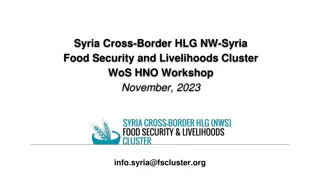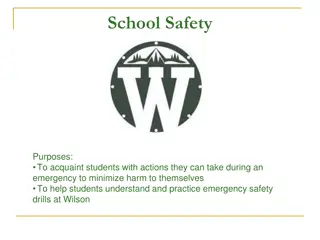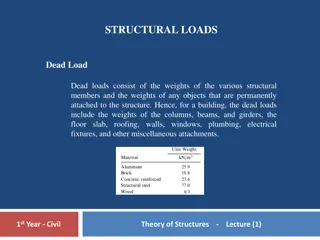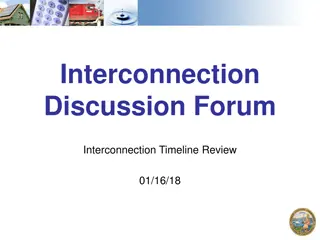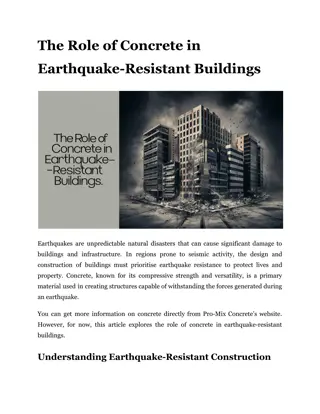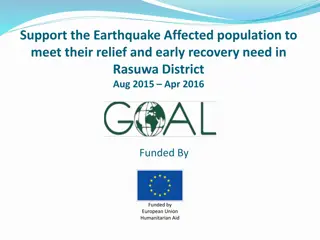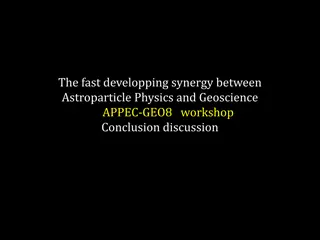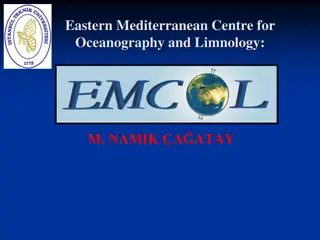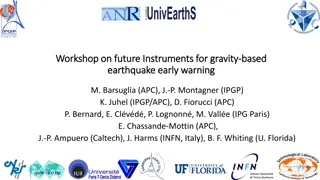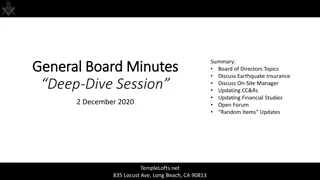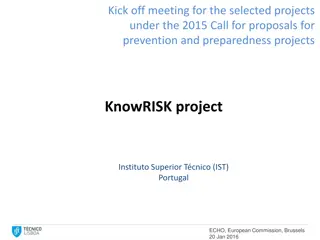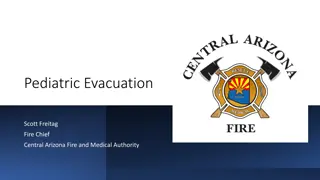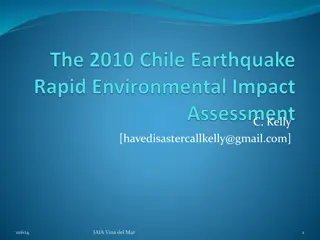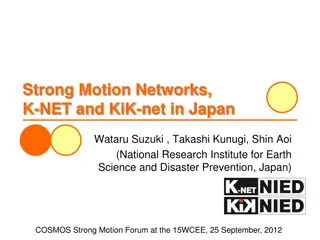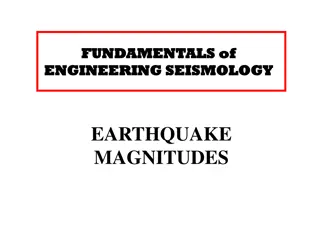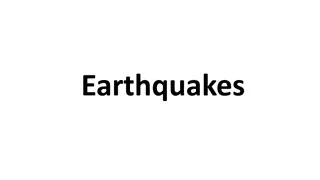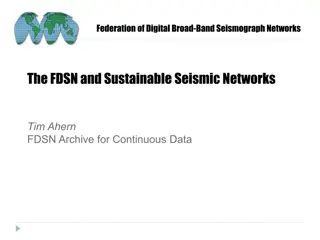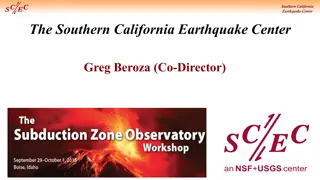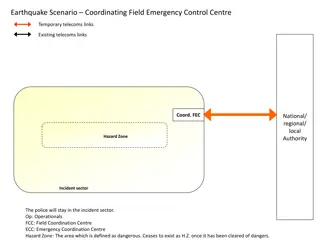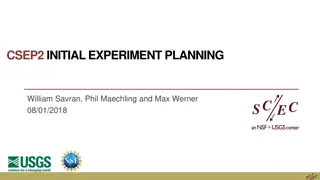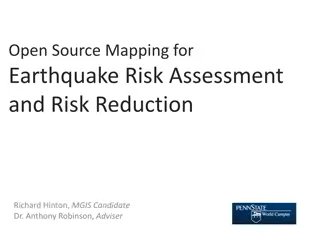Comprehensive Overview of CERT Basic Training and Incident Command System (ICS)
Neighborhood organizations and individuals can benefit from CERT Basic Training, learning about Disaster Preparedness, Medical Operations, Fire Safety, and more. The Incident Command System (ICS) provides a systematic approach to emergency response, emphasizing scalability and common terminology. Th
0 views • 29 slides
Urgent Support Needed: Nepal Earthquake Relief Efforts
A devastating 7.8 magnitude earthquake hit Nepal, causing widespread damage and leaving 2.8 million people homeless. Families are desperate for shelter as monsoon rains approach. Habitat is mobilizing engineers to assess damage, provide emergency shelter kits, and support long-term rebuilding effort
2 views • 16 slides
Understanding Types of Waves and Energy Transport
Explore the different types of waves such as transverse, longitudinal, and surface waves, along with electromagnetic waves. Learn about their properties, how they move through mediums, and their significance in various applications like sound transmission, earthquake detection, and energy transport.
3 views • 10 slides
Earthquake Safety and Design Considerations for Building Structures
Earthquake forces can lead to structural failure in buildings, posing a risk to lives and properties. Proper planning, reinforcement, and design elements such as bracing walls and tied members are essential for ensuring safety against earthquake forces. Additionally, consideration of soil type, qual
1 views • 22 slides
Understanding Tides and Earthquake Triggers
Spring tides occur when the moon is new or full, resulting in higher high tides and lower low tides. Neap tides follow, with moderate tides. Tides can trigger earthquakes due to stress and tidal components like normal and shear stresses. Statistical tests analyze the tidal phase angles at the time o
0 views • 25 slides
Food Security and Livelihoods Workshop in Northwest Syria - Highlights and Case Studies
Explore key remarks on changes in food security, impact of assistance, and earthquake consequences presented at the Food Security and Livelihoods Workshop in Northwest Syria. Discover insights on food secure and severely food insecure areas, along with case studies on intervention effectiveness and
8 views • 20 slides
Comprehensive Building Safety and Emergency Preparedness Training
Enhance your safety preparedness with Building Safety Coordinator Training, Emergency Preparedness resources, Communication Resources, Fire Safety procedures, and Earthquake Safety measures. Learn about fire extinguisher use, fire response procedures, earthquake safety considerations, and the seven
1 views • 30 slides
Emergency Preparedness and Safety Drills at Wilson School
Wilson School emphasizes the importance of emergency preparedness and safety drills to ensure the well-being of students. Various drills, including fire, earthquake, lockdown, and team response, are conducted to practice necessary actions in case of emergencies. Fire drills, for instance, are crucia
0 views • 19 slides
Understanding Structural Loads in Civil Engineering
Structural loads in civil engineering encompass dead loads from permanent structures, live loads that vary in magnitude and location, impact factors influencing rapid load application, wind loads due to blocked airflow, earthquake loads, and hydrostatic pressures for water-retaining structures. Thes
1 views • 6 slides
Interconnection Discussion Forum Timeline Review - 01/16/18
Interconnection Discussion Forum held on 01/16/18 discussed safety measures, meeting objectives, and timeline objectives. The agenda covered topics like submitting applications, engineering reviews, design, construction, and commissioning. Safety protocols for emergencies like earthquake and evacuat
0 views • 14 slides
Lessons Learned from Papua New Guinea's 2015-16 Drought in Dealing with the 2018 Earthquake
Exploring the correlation between the 2015-16 drought and the 2018 earthquake in Papua New Guinea offers valuable insights into disaster management strategies. Comparisons in impact, response, and long-term consequences highlight the importance of proactive measures and effective coordination in mit
0 views • 15 slides
Enhancing First Responder Skills for Disaster Response
This presentation highlights the crucial role of First Responders in earthquake scenarios, emphasizing the importance of coordination and timely action. It introduces the concept of First Responders, both professional and non-professional, and provides insights into their responsibilities, challenge
0 views • 12 slides
Optical Equipment Safety Review and Hazard Analysis
This document provides an in-depth review of the safety considerations for the ATST optical equipment, focusing on potential hazards associated with the M2 Mirror, Heat Stop Assembly, and other critical components. The Preliminary Hazard Analysis identifies various risks, causes, and recommended act
0 views • 13 slides
The Role of Concrete in Earthquake-Resistant Buildings
Discover how concrete enhances earthquake resilience in buildings. Learn key design features that make structures safer during seismic events.\n
6 views • 7 slides
Understanding Seismic Source Parameters in Earthquake Dynamics
The seismic source parameters in earthquake dynamics involve describing a fault as a discontinuity causing displacements, requiring a complex treatment of forces. The Earth's equilibrium necessitates a specific system of forces to explain displacements along faults. The seismic moment tensor, consis
4 views • 32 slides
Support for Earthquake-Affected Population in Rasuwa District, Aug 2015-Apr 2016
Support earthquake-affected population in Rasuwa District with shelter upgradation, material support, cash-for-work, livestock shed assistance, and earthquake-resistant techniques verification. Activities include distribution of shelter kits and tool kits, DRR training, mason training, construction
0 views • 13 slides
The Inspiring Story of Paul and Silas' Imprisonment
In Acts 16:22-30, it narrates how Paul and Silas were unjustly beaten and imprisoned, yet they chose to worship God through prayer and hymns. Their faithfulness led to a miraculous earthquake, opening prison doors and touching the heart of the jailer. Despite their circumstances, their worship was u
0 views • 14 slides
Visualizing Relationships with Data: Earthquakes, Volcanoes, and Plate Tectonics
Explore the locations of earthquakes and volcanoes to understand plate boundary zones, compare plate motion in different regions, and determine plate boundary zones using various data sources. Follow step-by-step instructions to study maps, analyze earthquake and volcano distributions, and engage in
0 views • 37 slides
Enhancing the Synergy Between Astroparticle Physics and Geoscience: APPEC-GEO8 Workshop Insights
The workshop discussion highlighted the growing synergy between Astroparticle Physics and Geoscience, emphasizing the importance of precise understanding of the Geosphere for studying the Cosmos. Topics included Neutrino tomography, deep life exploration, optical fibers coupled with sensors, seismic
1 views • 4 slides
Eastern Mediterranean Centre for Oceanography and Limnology (EMCOL): Research Focus and Facilities
EMCOL, led by M. Namik A. Atay, focuses on natural hazards, environmental changes, and earthquake risk assessment. Their research fields include earthquakes, submarine landslides, tsunamis, sea-level changes, climate change, and paleoclimatology. The center conducts fieldwork using various equipment
0 views • 13 slides
Workshop on Future Instruments for Gravity Earthquake Early Warning
Explore the cutting-edge research and developments in instruments for gravity-based early warning systems for earthquakes. Experts like M. Barsuglia, J.-P. Montagner, and K. Juhel are leading the way in this crucial field. Discover the latest projects and collaborations shaping the future of earthqu
0 views • 8 slides
Understanding Earthquake Impacts on Indoor Objects
Explore the relationship between earthquakes and indoor objects, including risks, behaviors, and protective measures. Learn about the impact of earthquakes on buildings and objects within them, as well as human behavior during seismic events. Discover the importance of rapid risk assessment using ar
0 views • 18 slides
Prepare and Stay Safe: A Comprehensive Guide for Earthquake Preparedness
This comprehensive guide covers various aspects of earthquake preparedness, including potential risks, necessary precautions, and steps to take during and after an earthquake. It emphasizes the importance of personal, family, and community preparedness, along with valuable insights on how to reduce
0 views • 102 slides
Board of Directors Meeting Highlights - December 2, 2020
Discussions during the Board of Directors meeting revolved around crucial topics such as Earthquake Insurance, On-Site Manager updates, CC&Rs, Financial Studies, and General Board matters. Key decisions were made regarding appointments, resignations, and handling earthquake insurance issues. The mee
0 views • 9 slides
KnowRISK Project - Kick-Off Meeting and Objectives Overview
The KnowRISK project aims to reduce seismic risks through non-structural elements in buildings. The kick-off meeting highlighted the project framework, partners, objectives, and the importance of addressing non-structural elements for earthquake resilience. Objectives include bridging the gap betwee
0 views • 10 slides
Pediatric Evacuation in Response to 7.7 Magnitude Earthquake
Central Arizona Fire and Medical Authority Fire Chief, Scott Freitag, coordinates pediatric evacuation efforts following a 7.7 magnitude earthquake in Southern California. Numerous hospitals report structural damages necessitating the evacuation of pediatric patients who require specialized care and
0 views • 19 slides
Environmental Impact Assessment and Recovery Planning After the 2010 Chile Earthquake
The presentation discusses the Rapid Environmental Impact Assessment (REA) process conducted by a team of Chileans post the 2010 earthquake. It emphasizes the incorporation of assessment results into post-disaster recovery planning to address key issues such as disaster debris management, transition
0 views • 6 slides
Overview of Strong Motion Networks K-NET and KiK-net in Japan
The Strong Motion Networks K-NET and KiK-net in Japan, managed by the National Research Institute for Earth Science and Disaster Prevention, provide crucial data on ground motion during earthquakes. K-NET consists of surface stations in populated areas, while KiK-net comprises pairs of surface and b
1 views • 7 slides
Inspiring Story of Overcoming Cyberbullying through Friendship
In the story "Save Our School!", Jess and Paddy work together to raise money for an earthquake fund by creating a successful computer game. Later, they help Chinmaya School in India with new classrooms. Samuels shares his experience of cyberbullying on social media and how he dealt with it courage a
0 views • 5 slides
Understanding Earthquake Magnitudes and Seismic Measurements
Delve into the fundamentals of engineering seismology and earthquake magnitudes, exploring topics such as fault dimensions, slip distribution, spectral shapes, Richter's observations, and logarithmic scales. Gain insights into how seismic measurements are characterized and understand the significanc
0 views • 69 slides
Understanding Earthquakes and Seismic Waves
This lecture delves into the nature and origin of earthquakes, discussing seismic waves, measurement techniques, effects of earthquakes on various Earth systems, and the relationship between earthquakes and plate tectonics. The content touches on topics like the impact of earthquakes on biosphere, h
0 views • 34 slides
Federation of Digital Broad-Band Seismograph Networks (FDSN) Overview
FDSN, founded in 1985, coordinates digital broad-band seismic networks globally to enhance seismic monitoring and research. It promotes site selection, data exchange, and instrument standardization, facilitating the installation of seismic stations across various scales to support earthquake studies
0 views • 15 slides
Southern California Earthquake Center Overview
The Southern California Earthquake Center (SCEC) is a large consortium of institutions dedicated to coordinating earthquake research in Southern California. Their mission involves communicating earthquake understanding to reduce risk and improve community resilience, integrating information for a co
0 views • 22 slides
Seismic Site Characterization in Metropolitan Vancouver
The Greater Vancouver area faces high seismic risk due to its population density and critical infrastructure. Ground shaking during large earthquakes depends on various factors including the earthquake source, material properties, and site conditions. Efforts are being made to map seismic hazards, u
0 views • 13 slides
Comprehensive Earthquake Emergency Response Scenarios
This detailed content outlines various earthquake emergency response scenarios including coordinating field control centers, temporary and existing telecoms links, national/regional/local authorities' roles, hazard zones, incident sectors, and specific tasks for different emergency teams such as sea
0 views • 9 slides
Earthquake Response and Recovery Exercise Overview
This presentation outlines the objectives, goals, and purpose of a tabletop exercise focused on evaluating response and recovery efforts after an earthquake. It emphasizes educating decision-makers, defining roles, coordinating operations, sharing information, and enhancing community resilience to e
0 views • 15 slides
Innovative Earthquake Monitoring Application PDL2AQMS in Action
PDL2AQMS is a Python application designed for injecting QuakeML data into AQMS databases, supporting both Oracle and Postgres systems. Developed by a team including Ellen Yu, Mike Hagerty, and Aparna Bhaskaran, this tool enables comparison of earthquake solutions and automates association processes.
0 views • 13 slides
Disaster Mitigation & Local Safety Training for Nepali Communities
This training program focuses on understanding disaster risks, particularly earthquakes, in Nepal. It covers topics such as the geographical structure of Nepal, responding to earthquake disasters, local safety mapping, types of disasters (natural and man-made), major disasters in Nepal, and historic
0 views • 26 slides
Advancing Earthquake Prediction with CSEP2: Principles, Experiments, and Collaboratory
Explore the pivotal planning and design concepts behind the Collaboratory for the Study of Earthquake Predictability (CSEP). Discover the guiding principles of CSEP2, objectives for experiment planning, and the framework for testing regions and centers. Delve into the roadmap for community-driven de
0 views • 11 slides
Open Source Mapping for Earthquake Risk Assessment and Reduction
This study explores the use of open-source mapping tools for earthquake risk assessment and reduction, emphasizing the importance of utilizing Free and Open Source Software (FOSS) in disaster management. By leveraging freely available geospatial data and software, individuals can identify vulnerable
0 views • 18 slides





